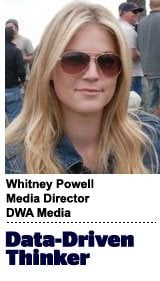 “Data-Driven Thinking” is written by members of the media community and contains fresh ideas on the digital revolution in media.
“Data-Driven Thinking” is written by members of the media community and contains fresh ideas on the digital revolution in media.
Today’s column is written by Whitney Powell, media director at DWA Media.
Viewability is a common problem all advertisers share: If an ad is never seen, it can never drive impact. Viewability should be a no-brainer – not a KPI – especially for business-to-business (B2B) brands that have fewer potential customers to begin with.
When I was in the business-to-consumer (B2C) marketing world, viewability was a standard requirement. It was a widely accepted practice to ask for viewability.
But now that I’m in the business-to-business world, I’ve noticed many brands aren’t talking about or actively requesting viewability insights across their digital campaigns.
The ads of any B2B marketer looking to drive business impact must be viewable to drive intent action or drive ROI. B2B marketers’ audience is finite with high competition across the space. We know their audience is already smaller than, say, L’Oreal’s, which can target millions of women with a new lipstick product, compared to a new storage hardware product that may only target 100,000 key IT individuals.
In the B2B world, every ad counts. That is why viewability is so key to understanding performance impact.
Wake Up
These days, when I talk to former B2C co-workers, they are surprised to hear that viewability is so unfamiliar in the B2B world. It’s true. Many B2B marketers don’t know they should be asking for it. It seems obvious that driving a qualified user to convert requires an ad to be seen, but sadly, many B2B marketers don’t know how to measure this type of metric or optimize for it.
B2B marketers can easily waste 50% of their marketing budget. If they don’t pay attention to viewability or insist on implementing standard viewability requirements, their media partners can exploit this lack of attention. B2B marketers need to know what is in line with industry standards and ask for it.
Understand What Viewability Actually Is
I often ask B2B marketers to spell out their definition of viewability. People’s understanding of viewability varies widely. While some have a vague idea of what it means, few are comfortable with speaking to industry averages, its measurement and implementation.
It’s important to get clear. I recommend that those who are not versed in viewability to read the latest guidelines from the Media Rating Council [PDF], which state that viewable ad impressions must meet the threshold where 50% of pixels are visible on a browser or device for at least one continuous second.
This is a surprisingly low bar. Shouldn’t everyone aim higher?
Demand Viewability And Accountability
As the IAB’s Randall Rothenberg has pointed out, it’s time to fix the Tower of Babel when it comes to viewability. In just the past year, great strides have been made to move the industry toward a better, more viewable future. Luckily ad verification companies, such as Integral Ad Science, are partnering with many industry heavyweights to do just that.
But these advances aren’t well understood by many B2B marketers who simply rely on their publishing partners and media owners to provide them with “high-quality” digital inventory.
Some partners may feign ignorance when they are called out on low viewability for campaigns. B2B marketers must fight against CPM increases for meeting basic viewability standards set by the IAB. This behavior is unacceptable so these kinds of media partners quickly lose trust and advertising budgets.
Beat The Bots To Reach Buyers
Low viewability tends to come with high levels of fraud, and with fraud come bots. Bots nowadays are quite sophisticated, with some able to fill out lead forms and engage with ad units. The higher the viewability, the more confident marketers can be about the performance and intent actions tied to their media and the more impact they will see at a business level.
For now, all publishers and vendors should strive to at least hit the IAB’s suggested 70% viewability benchmark as a matter of course. Brands can and should demand it.
Some vendors get away with 20% viewability but you will see the inverse impact in performance. While this level of viewability is unacceptable, expecting 100% viewability just isn’t realistic, either, due to scrolling and mobile formats. Viewability is a digital problem and internet issue.
Still, the IAB keeps evolving and may alter the definition as time goes on, which is why it’s key to stay abreast of changes within the industry and from IAB.
Decide The Requirements
B2B marketers must define their requirements at the campaign level.
If they’re aiming for 60-70% viewability across a campaign, they need to make sure they hold their media agencies and partners accountable for hitting that percentage. Many B2C brands work with ad verification partners to corroborate viewability rates reported by their agencies.
B2B marketers should ask if their media agency works with any ad verification partners. Marketers should ask agencies how they measure viewability and optimize against fraudulent traffic. After all, they don’t want only bots looking at and engaging with their ads. Trust but verify.
Get Clear On Who Is Paying
Viewability comes at a cost, because the technology to measure isn’t free. There’s the software to consider as well as the personnel to optimize to its success. But the end results save brands thousands of dollars that might be wasted otherwise.
Given the partnership and investment level, many media partners are willing to take on the ad verification cost to ensure transparency and quality of media on behalf of clients. When a brand is spending $50,000 to $100,000 for a campaign, a few thousand for viewability should be a professional courtesy. It’s in everyone’s best interest to assure quality and viewability.
The first step B2B marketers can take to ensure their media budgets aren’t wasted on fraudulent or unseen impressions is to begin holding their media partners accountable. If B2B marketers don’t feel entirely comfortable in their knowledge of viewability, there’s a simple solution: Ask for it. They don’t have to be a viewability expert to set requirements for their media.
Follow DWA (@dwaTechMedia) and AdExchanger (@adexchanger) on Twitter.












